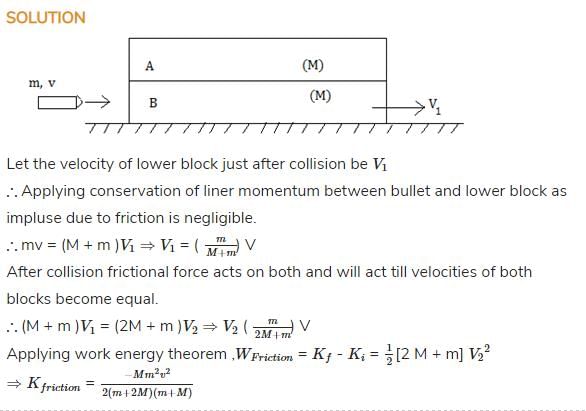JEE Exam > JEE Questions > Two identical blocks A and B of mass M each a...
Start Learning for Free
Two identical blocks A and B of mass M each are kept on each other on a smooth horizontal plane. There exists friction between A and B. A bullet of mass m hits the lower block with a horizontal velocity v and goes embedded into it. Find work done by friction between A and B?
Verified Answer
Two identical blocks A and B of mass M each are kept on each other on ...

 This question is part of UPSC exam. View all JEE courses
This question is part of UPSC exam. View all JEE courses
Most Upvoted Answer
Two identical blocks A and B of mass M each are kept on each other on ...
Problem Statement:
Two identical blocks A and B of mass M each are kept on each other on a smooth horizontal plane. There exists friction between A and B. A bullet of mass m hits the lower block with a horizontal velocity v and goes embedded into it. Find work done by friction between A and B?
Solution:
Given:
Mass of block A = Mass of block B = M
Mass of bullet = m
Velocity of bullet = v
Approach:
To find the work done by friction between blocks A and B, we need to determine the relative displacement between the two blocks. We can analyze the problem in two stages:
1. Collision Stage:
In this stage, the bullet collides with block A and gets embedded into it. Due to the collision, the system experiences an impulse, which causes the blocks to move together with a common velocity, let's say V.
2. Sliding Stage:
In this stage, the blocks A and B move together with a common velocity V. The friction between the blocks opposes their relative motion. We need to calculate the work done by this friction force.
Let's calculate each stage in detail.
1. Collision Stage:
During the collision, the momentum of the system is conserved. Therefore, we can write the equation:
(m * v) + (M * 0) = (M + m) * V
Simplifying the equation, we get:
m * v = (M + m) * V
V = (m * v) / (M + m)
2. Sliding Stage:
During the sliding stage, the friction force between blocks A and B opposes their relative motion. The work done by friction is given by the equation:
Work = Friction force * Displacement
The friction force can be calculated using the equation:
Friction force = μ * Normal force
The normal force on block A is equal to its weight, which is M * g, where g is the acceleration due to gravity.
The displacement during the sliding stage is given by the equation:
Displacement = V * t
where t is the time taken during the sliding stage.
Now, let's calculate the work done by friction.
Work = (μ * M * g) * (V * t)
Substituting the value of V from the collision stage equation, we get:
Work = (μ * M * g) * ((m * v) / (M + m)) * t
Now, we have the expression for the work done by friction between blocks A and B.
Two identical blocks A and B of mass M each are kept on each other on a smooth horizontal plane. There exists friction between A and B. A bullet of mass m hits the lower block with a horizontal velocity v and goes embedded into it. Find work done by friction between A and B?
Solution:
Given:
Mass of block A = Mass of block B = M
Mass of bullet = m
Velocity of bullet = v
Approach:
To find the work done by friction between blocks A and B, we need to determine the relative displacement between the two blocks. We can analyze the problem in two stages:
1. Collision Stage:
In this stage, the bullet collides with block A and gets embedded into it. Due to the collision, the system experiences an impulse, which causes the blocks to move together with a common velocity, let's say V.
2. Sliding Stage:
In this stage, the blocks A and B move together with a common velocity V. The friction between the blocks opposes their relative motion. We need to calculate the work done by this friction force.
Let's calculate each stage in detail.
1. Collision Stage:
During the collision, the momentum of the system is conserved. Therefore, we can write the equation:
(m * v) + (M * 0) = (M + m) * V
Simplifying the equation, we get:
m * v = (M + m) * V
V = (m * v) / (M + m)
2. Sliding Stage:
During the sliding stage, the friction force between blocks A and B opposes their relative motion. The work done by friction is given by the equation:
Work = Friction force * Displacement
The friction force can be calculated using the equation:
Friction force = μ * Normal force
The normal force on block A is equal to its weight, which is M * g, where g is the acceleration due to gravity.
The displacement during the sliding stage is given by the equation:
Displacement = V * t
where t is the time taken during the sliding stage.
Now, let's calculate the work done by friction.
Work = (μ * M * g) * (V * t)
Substituting the value of V from the collision stage equation, we get:
Work = (μ * M * g) * ((m * v) / (M + m)) * t
Now, we have the expression for the work done by friction between blocks A and B.

|
Explore Courses for JEE exam
|

|
Similar JEE Doubts
Question Description
Two identical blocks A and B of mass M each are kept on each other on a smooth horizontal plane. There exists friction between A and B. A bullet of mass m hits the lower block with a horizontal velocity v and goes embedded into it. Find work done by friction between A and B? for JEE 2025 is part of JEE preparation. The Question and answers have been prepared according to the JEE exam syllabus. Information about Two identical blocks A and B of mass M each are kept on each other on a smooth horizontal plane. There exists friction between A and B. A bullet of mass m hits the lower block with a horizontal velocity v and goes embedded into it. Find work done by friction between A and B? covers all topics & solutions for JEE 2025 Exam. Find important definitions, questions, meanings, examples, exercises and tests below for Two identical blocks A and B of mass M each are kept on each other on a smooth horizontal plane. There exists friction between A and B. A bullet of mass m hits the lower block with a horizontal velocity v and goes embedded into it. Find work done by friction between A and B?.
Two identical blocks A and B of mass M each are kept on each other on a smooth horizontal plane. There exists friction between A and B. A bullet of mass m hits the lower block with a horizontal velocity v and goes embedded into it. Find work done by friction between A and B? for JEE 2025 is part of JEE preparation. The Question and answers have been prepared according to the JEE exam syllabus. Information about Two identical blocks A and B of mass M each are kept on each other on a smooth horizontal plane. There exists friction between A and B. A bullet of mass m hits the lower block with a horizontal velocity v and goes embedded into it. Find work done by friction between A and B? covers all topics & solutions for JEE 2025 Exam. Find important definitions, questions, meanings, examples, exercises and tests below for Two identical blocks A and B of mass M each are kept on each other on a smooth horizontal plane. There exists friction between A and B. A bullet of mass m hits the lower block with a horizontal velocity v and goes embedded into it. Find work done by friction between A and B?.
Solutions for Two identical blocks A and B of mass M each are kept on each other on a smooth horizontal plane. There exists friction between A and B. A bullet of mass m hits the lower block with a horizontal velocity v and goes embedded into it. Find work done by friction between A and B? in English & in Hindi are available as part of our courses for JEE.
Download more important topics, notes, lectures and mock test series for JEE Exam by signing up for free.
Here you can find the meaning of Two identical blocks A and B of mass M each are kept on each other on a smooth horizontal plane. There exists friction between A and B. A bullet of mass m hits the lower block with a horizontal velocity v and goes embedded into it. Find work done by friction between A and B? defined & explained in the simplest way possible. Besides giving the explanation of
Two identical blocks A and B of mass M each are kept on each other on a smooth horizontal plane. There exists friction between A and B. A bullet of mass m hits the lower block with a horizontal velocity v and goes embedded into it. Find work done by friction between A and B?, a detailed solution for Two identical blocks A and B of mass M each are kept on each other on a smooth horizontal plane. There exists friction between A and B. A bullet of mass m hits the lower block with a horizontal velocity v and goes embedded into it. Find work done by friction between A and B? has been provided alongside types of Two identical blocks A and B of mass M each are kept on each other on a smooth horizontal plane. There exists friction between A and B. A bullet of mass m hits the lower block with a horizontal velocity v and goes embedded into it. Find work done by friction between A and B? theory, EduRev gives you an
ample number of questions to practice Two identical blocks A and B of mass M each are kept on each other on a smooth horizontal plane. There exists friction between A and B. A bullet of mass m hits the lower block with a horizontal velocity v and goes embedded into it. Find work done by friction between A and B? tests, examples and also practice JEE tests.

|
Explore Courses for JEE exam
|

|
Signup to solve all Doubts
Signup to see your scores go up within 7 days! Learn & Practice with 1000+ FREE Notes, Videos & Tests.





















